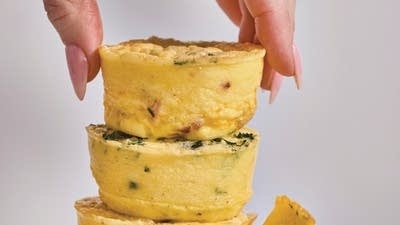
About every decade it occurs to America that Southern cooking is pretty extraordinary. We're in one of those moments right now.
The Southern biscuit is a separating-the-men-from-the-boys achievement. Nathalie Dupree, one of the queens of Southern cooking and co-author of Mastering the Art of Southern Cooking with Cynthia Graubart, shares her secrets for making biscuits.
Lynne Rossetto Kasper: I want to talk biscuits with you because the biscuits I had at your house many years ago in Atlanta were my biscuit epiphany. They were like an angel's wings; I had never eaten biscuits like this.
Let's break down the process. First of all, the flour in the South is different from the flour anywhere else; it's a self-rising, soft, wheat flour. White Lily is one of the brands that everybody loves, right?
 Mastering the Art of Southern Cooking
Mastering the Art of Southern Cooking
Nathalie Dupree: Right. There's Martha White and also Southern Biscuit. There are a lot of different ones, but their commonality is that they're historically winter wheat. That meant they were grown in the winter where Midwestern and Northern wheats were grown in the summer, so they had lower gluten. This was disparaged by the North, but it was wonderful for the South where there was a tradition of English food, which included hardtack and some of those harder biscuits before the advent of baking powder. So, it is lower in gluten; you can tell that by looking at the side of the package under protein.
LRK: The protein content should be what -- about eight to 10 grams of protein?
ND: For Southern flours, they will go down to 8 or 9, and Northern flours or bread flours will go up to 14.
LRK: But in the North, if you mix all-purpose flour with cake flour, you should be able to simulate it (a formula in the book tells you how to recreate that). Now, the fat -- we're talking butter, lard or shortening?
ND: Right. And whipping cream as well. I tell everyone if they really want to make a perfect biscuit, go to the grocery store and buy lard, shortening, butter, whipping cream and several kinds of flour; go to their kitchen, lock themselves in and practice making the biscuit that they like the best. Because everyone likes a different biscuit. Once you get to the biscuit you like, then you can learn to accommodate if you want to make somebody else's biscuit, or somebody else's mother's biscuit. But you have to practice. It's not something that people are born with; they learned from watching. For instance, Kate, who was a wonderful biscuit maker -- we break down her process.
LRK: Those were the biscuits I tasted in Atlanta.
ND: That's right. Kate's dough was really always very wet. You can stick your finger in her dough and there will still be dough clinging to your finger when it comes out -- little speckles, not globby wet, but wet.
LRK: That allows for a lot more steam.
 Dupree's recipe: Two-Ingredient Biscuits
Dupree's recipe: Two-Ingredient Biscuits
ND: Yes, and as the dough sits, interestingly enough, it does get dryer. It seems to absorb the flour a little bit. So if it's dry when you start, by the time you roll it out and cut it out, you're going to be in trouble.
Now, the three things that combine in making flour activated are liquid, manipulation and heat. And then if you add fat, that will tenderize the dough. So, we work our biscuit dough just like our pie dough: as little as possible and the lighter the fat, the lighter the biscuit. My favorite biscuits to teach with are the two-ingredient biscuits that we make, which are just self-rising flour and whipping cream.
We just lightly stir those two together and then flop them out. There are some plastic boards that you can buy in the grocery store that fold that are like three for $2. You have those on the counter and you just flop your dough out on them, with it lightly floured. Then you fold those plastic sheets or you fold it with your hands, pat it out, fold it again, pat it out, and fold it again.
LRK: So you're building layers like a puff pastry?
ND: Yes. You're not kneading it; kneading is a vicious word. We don't knead biscuits; we manipulate them or we pat them. So we pat and fold the dough in half twice, and then the third time we cut it out. And you can fold it more like a puff pastry if you want to, but we have a two-fold biscuit and then the third time you cut it out. Then it splits easily so that you can put butter in it.
Before you go...
Each week, The Splendid Table brings you stories that expand your world view, inspire you to try something new, and show how food connects us all. We rely on your generous support. For as little as $5 a month, you can have a lasting impact on The Splendid Table. And, when you donate, you’ll join a community of like-minded individuals who love good food, good conversation, and kitchen companionship. Show your love for The Splendid Table with a gift today.
Thank you for your support.
Donate today for as little as $5.00 a month. Your gift only takes a few minutes and has a lasting impact on The Splendid Table and you'll be welcomed into The Splendid Table Co-op.




